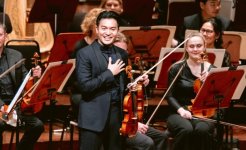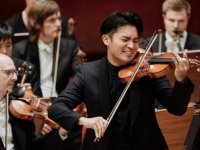World-renowned virtuoso Ray Chen has recently invited the public into the inner sanctum of his artistry through a series of open practice sessions on Tonic.
Far beyond mere rehearsal, these sessions revealed a meticulous and deeply technical pursuit of what Chen terms a “premium sound”—a sound shaped by micro-adjustments in technique, interpretive insight, and collaborative sensitivity.
This journey culminated in an electrifying performance of the Tchaikovsky Violin Concerto on the Bangkok stage, where practice was transformed into transcendent artistry.

Defining Premium Sound: The Synergy of Technique and Intention
“Premium sound,” a term often used vaguely in classical music circles, gains precision in Chen’s hands. It is the product of exacting control over three fundamental elements of bow technique: speed, pressure, and contact point.
Bow Speed: Chen manipulates bow speed dynamically within phrases to color sound texture and intensity. Faster speeds yield brilliance and projection, while slower speeds produce warmth and intimacy.
Bow Pressure: With nuanced control, Chen applies pressure to coax a clear, resonant tone free of scratchiness or thinness, sustaining richness even in the quietest passages.
Contact Point: By shifting the bow’s contact along the string—from sul ponticello’s bright focus near the bridge to sul tasto’s mellow timbre near the fingerboard—he sculpts the tonal palette with remarkable subtlety.
These technical parameters are not ends in themselves but are in service of emotional communication.
Chen’s microscopic adjustments are akin to a painter’s brushstrokes—each movement contributes to a sonic tapestry dense with meaning.
The Art of “Lift”: Rhythmic Elasticity and Expressive Nuance
Central to Chen’s interpretive toolkit is the concept of “lift,” a refined bow articulation involving a slight anticipatory attack followed by a gentle bounce.
Technically, this entails a rapid decrease in bow hair pressure post-attack, creating a light rebound that animates rhythmic patterns.
This subtle technique injects elasticity into repeated motifs, particularly in Tchaikovsky’s music, where repetition functions as emotional intensification rather than mere reiteration.
The lift enhances rhythmic character without breaking the musical line, achieving a delicate balance between legato and articulated phrasing.
Long-Bow Mastery and the Power of “Choked” Tones
The finale of the Tchaikovsky Concerto showcases Chen’s command over sustained bow control and tonal variation. Long-bow technique demands consistent arm and shoulder engagement to maintain stable bow speed and pressure across extended phrases, preserving tonal integrity and emotional momentum.
“Choked” tones—achieved by a swift reduction of bow speed and pressure—create an almost vocal-like constriction, amplifying emotional tension and release. Chen employs this sparingly but with profound effect, heightening climactic moments and deepening the listener’s engagement.
Interpretation and Contrast: Brahms and Tchaikovsky
Chen’s interpretative distinctions reveal a sophisticated musicological understanding.
Brahms’s music, with its structural complexity and emotional restraint, calls for a sound imbued with “aching longing”—a controlled vibrato and carefully shaped phrasing evoke its latent tension.
Conversely, Tchaikovsky’s concerto demands fiery sensuality and emotional immediacy.
Chen’s approach emphasizes the composer’s rhythmic repetition as a source of gratification and intensification, with the lift technique reinforcing the music’s fiery pulse.
Collaborative Sensitivity: The Fragility of Ensemble Balance
Chen’s rehearsal approach underscores the delicate balance between soloist and orchestra. He treats ensemble playing as a dynamic conversation requiring mutual responsiveness; failure in this balance leads to the collapse of the musical architecture.
His meticulous listening and adaptive playing highlight emotional intelligence alongside technical skill, modulating dynamics and timing to support a cohesive, expressive whole.
From Practice to Performance: The Bangkok Realization
The culmination of these practice philosophies was witnessed in Bangkok, where Chen’s Tchaikovsky performance transcended mere technical display. The dark, mysterious opening movement enveloped the audience in atmosphere and emotional depth; the second movement flowed with pirouette-like grace, enhanced by subtle lifts and delicate phrasing; the finale erupted with a thrilling fusion of control and passion, driven by long-bow mastery and poignant choked tones.
Transparency and Legacy: Connecting Through Tonic
By sharing his practice process openly on Tonic, Chen breaks down the myth of effortless genius. He offers a rare window into the continuous, rigorous work underpinning mastery, inspiring musicians and audiences alike to appreciate artistry as an evolving, shared journey.

Conclusion: The New Virtuosity Paradigm
Ray Chen’s “premium sound” epitomizes a new standard of virtuosity—one where technical precision, interpretive depth, and collaborative sensitivity converge. His Bangkok triumph stands as a testament to the power of deliberate, intelligent practice transformed into profound artistic expression.
In Chen’s hands, the violin becomes not just an instrument but a medium for sculpting sound, emotion, and human connection.
Far beyond mere rehearsal, these sessions revealed a meticulous and deeply technical pursuit of what Chen terms a “premium sound”—a sound shaped by micro-adjustments in technique, interpretive insight, and collaborative sensitivity.
This journey culminated in an electrifying performance of the Tchaikovsky Violin Concerto on the Bangkok stage, where practice was transformed into transcendent artistry.

Defining Premium Sound: The Synergy of Technique and Intention
“Premium sound,” a term often used vaguely in classical music circles, gains precision in Chen’s hands. It is the product of exacting control over three fundamental elements of bow technique: speed, pressure, and contact point.
Bow Speed: Chen manipulates bow speed dynamically within phrases to color sound texture and intensity. Faster speeds yield brilliance and projection, while slower speeds produce warmth and intimacy.
Bow Pressure: With nuanced control, Chen applies pressure to coax a clear, resonant tone free of scratchiness or thinness, sustaining richness even in the quietest passages.
Contact Point: By shifting the bow’s contact along the string—from sul ponticello’s bright focus near the bridge to sul tasto’s mellow timbre near the fingerboard—he sculpts the tonal palette with remarkable subtlety.
These technical parameters are not ends in themselves but are in service of emotional communication.
Chen’s microscopic adjustments are akin to a painter’s brushstrokes—each movement contributes to a sonic tapestry dense with meaning.
The Art of “Lift”: Rhythmic Elasticity and Expressive Nuance
Central to Chen’s interpretive toolkit is the concept of “lift,” a refined bow articulation involving a slight anticipatory attack followed by a gentle bounce.
Technically, this entails a rapid decrease in bow hair pressure post-attack, creating a light rebound that animates rhythmic patterns.
This subtle technique injects elasticity into repeated motifs, particularly in Tchaikovsky’s music, where repetition functions as emotional intensification rather than mere reiteration.
The lift enhances rhythmic character without breaking the musical line, achieving a delicate balance between legato and articulated phrasing.
Long-Bow Mastery and the Power of “Choked” Tones
The finale of the Tchaikovsky Concerto showcases Chen’s command over sustained bow control and tonal variation. Long-bow technique demands consistent arm and shoulder engagement to maintain stable bow speed and pressure across extended phrases, preserving tonal integrity and emotional momentum.
“Choked” tones—achieved by a swift reduction of bow speed and pressure—create an almost vocal-like constriction, amplifying emotional tension and release. Chen employs this sparingly but with profound effect, heightening climactic moments and deepening the listener’s engagement.
Interpretation and Contrast: Brahms and Tchaikovsky
Chen’s interpretative distinctions reveal a sophisticated musicological understanding.
Brahms’s music, with its structural complexity and emotional restraint, calls for a sound imbued with “aching longing”—a controlled vibrato and carefully shaped phrasing evoke its latent tension.
Conversely, Tchaikovsky’s concerto demands fiery sensuality and emotional immediacy.
Chen’s approach emphasizes the composer’s rhythmic repetition as a source of gratification and intensification, with the lift technique reinforcing the music’s fiery pulse.
Collaborative Sensitivity: The Fragility of Ensemble Balance
Chen’s rehearsal approach underscores the delicate balance between soloist and orchestra. He treats ensemble playing as a dynamic conversation requiring mutual responsiveness; failure in this balance leads to the collapse of the musical architecture.
His meticulous listening and adaptive playing highlight emotional intelligence alongside technical skill, modulating dynamics and timing to support a cohesive, expressive whole.
From Practice to Performance: The Bangkok Realization
The culmination of these practice philosophies was witnessed in Bangkok, where Chen’s Tchaikovsky performance transcended mere technical display. The dark, mysterious opening movement enveloped the audience in atmosphere and emotional depth; the second movement flowed with pirouette-like grace, enhanced by subtle lifts and delicate phrasing; the finale erupted with a thrilling fusion of control and passion, driven by long-bow mastery and poignant choked tones.
Transparency and Legacy: Connecting Through Tonic
By sharing his practice process openly on Tonic, Chen breaks down the myth of effortless genius. He offers a rare window into the continuous, rigorous work underpinning mastery, inspiring musicians and audiences alike to appreciate artistry as an evolving, shared journey.

Conclusion: The New Virtuosity Paradigm
Ray Chen’s “premium sound” epitomizes a new standard of virtuosity—one where technical precision, interpretive depth, and collaborative sensitivity converge. His Bangkok triumph stands as a testament to the power of deliberate, intelligent practice transformed into profound artistic expression.
In Chen’s hands, the violin becomes not just an instrument but a medium for sculpting sound, emotion, and human connection.